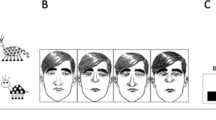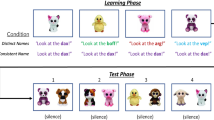Abstract
The category knowledge and receptive language skills of 16 autistic, mentally retarded, and normal children were assessed. The autistic children's knowledge of function, form, and color categories was comparable to that of the mental- age- matched mentally retarded and normal comparison groups. Category knowledge and receptive language were more closely associated for mentally retarded and normal children than for autistic children. The findings indicate that category knowledge is not sufficient for the development of receptive language in autistic children.
Similar content being viewed by others
References
American Psychiatric Association. (1980).Diagnostic and statistical manual of mental disorders (3rd ed.). Washington, D.C.: Author.
Bates, E., Camaioni, L., & Volterra, V. (1975). The acquisition of performatives prior to speech.Merrill-Palmer Quarterly, 21, 205–226.
Battig, W., & Montague, W. (1969). Category norms of verbal items in 56 categories: A replication and extension of the Connecticut category norms.Journal of Experimental Psychology, 80, 1–46.
Beckwith, L., & Thompson, S. (1976). Recognition of verbal labels of pictured objects and events by 17- to 30-month-old infants.Journal of Speech and Hearing Research, 19, 690–699.
Lancy, D., & Goldstein, G. (1982). The use of non verbal Piagetian tasks to assess the cognitive development of autistic children.Child Development, 53, 1233–1241.
Lotter, V. (1978). Follow-up studies. In M. Rutter & E. Schopler (Eds.),Autism: A reappraisal of concepts and treatment (pp. 475–495). New York: Plenum.
Moore, M. K., & Meltzoff, A. (1978). Object permanence, imitation, and language development in infancy: Toward a neo-Piagetian perspective on communicative and cognitive development. In F. Minifie & L. Lloyd (Eds.),Communicative and cognitive abilities-Early behavioral assessment. Baltimore: University Park Press.
Nelson, K. (1979). Explorations in the development of a functional semantic system. In W. A. Collins (Ed.),Minnesota Symposia on Child Psychology, 12, 47–81.
Ricciuti, H. (1965). Object grouping and selective ordering behavior in infants 12 to 24 months old.Merrill-Palmer Quarterly, 2, 129–148.
Rutter, M. (1978). Language disorder and infantile autism. In M. Rutter & E. Schopler (Eds.),Autism: A reappraisal of concepts and treatment (pp. 85–104). New York: Plenum.
Rutter, M. (1979). Language, cognition, and autism. In R. Katzman (Ed.),Congenital and acquired cognitive disorders (pp. 247–264). New York: Raven Press.
Rutter, M. (1983). Cognitive deficits in the pathogenesis of autism.Journal of Child Psychology and Psychiatry, 24, 513–531.
Rutter, M., & Lockyer, L. (1967). A five to fifteen year follow-up study of infantile psychosis. I. Description of sample.British Journal of Psychiatry, 113, 1169–1182.
Sigman, M., & Ungerer, J. (1984). Cognitive and language skills in autistic, mentally retarded, and normal children.Developmental Psychology, 20, 293–302.
Slotnick, C. (1983).Spontaneous and provoked class sorting behavior among autistic and normal children. Paper presented at the biennial meeting of the Society for Research in Child Development, Detroit, Michigan.
Sugarman, S. (1981). The cognitive basis of classification in very young children: An analysis of object-ordering trends.Child Development, 52, 1172–1178.
Sugarman, S. (1983).Children's early thought. Cambridge, England: Cambridge University Press.
Tager-Flusberg, H. (1981). On the nature of linguistic functioning in early infantile autism.Journal of Autism and Developmental Disorders, 11, 45–56.
Ungerer, J. (1985). The autistic child. In M. Sigman (Ed.),Children with emotional disorders and developmental disabilities: Assessment and treatment. Orlando, Florida: Grune and Stratton.
Ungerer, J., & Sigman, M. (1981). Symbolic play and language comprehension in autistic children.Journal of the American Academy of Child Psychiatry, 20, 318–337.
Ungerer, J., & Sigman, M. (1984). The relation of play and sensorimotor behavior to language in the second year.Child Development, 55, 1448–1455.
Author information
Authors and Affiliations
Additional information
Support for this research was provided by Grant 12–41 from the March of Dimes, Biobehavioral Research Support Grant 516, National Institute of Mental Health (NIMH) Grant MH33815, and NIMH Postdoctoral Fellowship 1 F32 MH 07550. Subjects were recruited from the University of California, Los Angeles, Clinical Research Center (CRC) for the Study of Childhood Psychosis, funded by NIMH Grant MH30897. We thank members of the CRC, particularly Peter Tanguay, Barbara Fish, and B. J. Freeman, for their support of our research efforts. We also thank Mary Beth Sorensen and M. Holly Hackman for their assistance in data collection, Carmen Gibbon for her help in preparation of the manuscript, and Dolores Adams and Gwenda Aitchison for their help in data analysis. Peter Mundy, Rosa Needleman, and Tracy Sherman also contributed significantly to this project.
Rights and permissions
About this article
Cite this article
Ungerer, J.A., Sigman, M. Categorization skills and receptive language development in autistic children. J Autism Dev Disord 17, 3–16 (1987). https://doi.org/10.1007/BF01487256
Issue Date:
DOI: https://doi.org/10.1007/BF01487256




